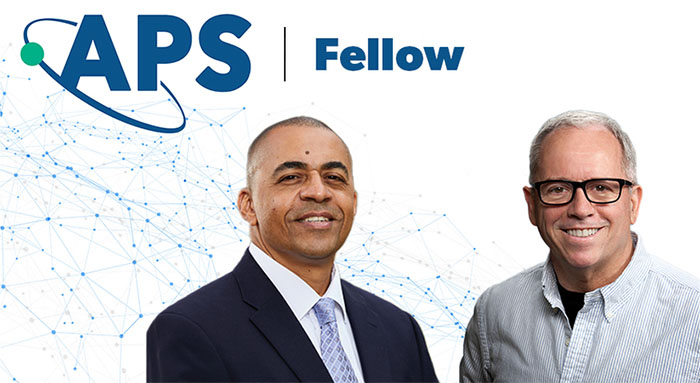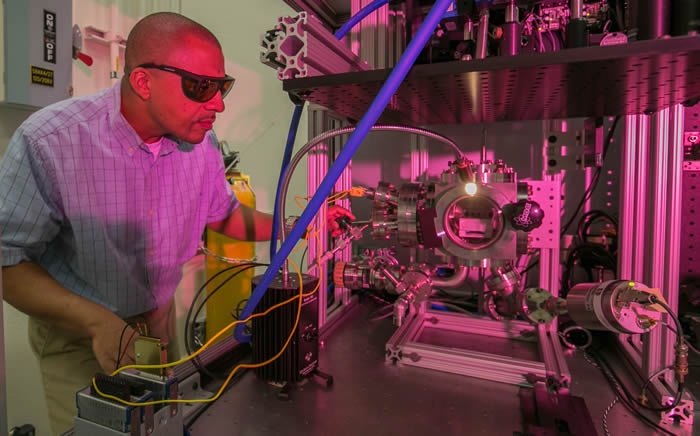Ibo Matthews, Frank Graziani Named American Physical Society Fellows
October 31, 2023
LLNL’s Manyalibo (Ibo) Matthews, who began his Livermore career helping mitigate optics damage on NIF, and Frank Graziani, who works to foster academic collaborations in high energy density (HED) research which often relies on NIF, have been selected as 2023 American Physical Society (APS) fellows.
 Ibo Matthews (left) and Frank Graziani are LLNL’s latest APS Fellows.
Ibo Matthews (left) and Frank Graziani are LLNL’s latest APS Fellows. Matthews was selected by the Forum in Industrial and Applied Physics “for pioneering research in optimizing metal 3D printing and laser materials processing.”
Graziani was chosen by the Division of Plasma Physics “for original theoretical and computational contributions on the frontiers of fundamental properties of non-ideal plasmas, and for exceptional leadership in the national boost initiative, including mentoring and educating the broader high energy density physics community.”
The APS Fellowship Program was created to recognize members who may have made advances in physics through original research and publication, or made significant innovative contributions in the application of physics to science and technology. They also may have made significant contributions to the teaching of physics or service and participation in the activities of the society.
Fellowship is a distinct honor signifying recognition by one’s professional peers. Each year, no more than one half of 1 percent of the society’s membership (excluding student members) is recognized by their peers for election to the status of fellow of the American Physical Society.
Ibo Matthews
A 17-year Lab veteran, Matthews began his career in industrial research at Bell Laboratories, where he worked for eight years in photonic materials research. He is a trained experimental condensed matter physicist and currently serves as the division leader for Materials Science within the Physical and Life Sciences (PLS) Directorate.
With his background in optics and microscopy and a passion for research, Matthews was a natural fit for NIF when he joined LLNL in 2006. With NIF under construction at the time, there was a need to study optical materials and to understand the effects of the intense ultraviolet light from NIF’s lasers on the optics in NIF’s final optics assemblies.
Matthews joined the PLS Directorate and was immediately matrixed into the NIF & Photon Science Directorate. He went to work with the Optical Damage Group characterizing, understanding, and finding ways to prevent and repair damage to NIF optics. He also studied problems related to laser materials processing and directed-energy weapon systems.
That work in laser materials processing eventually branched out to include studies to understand the physics of laser-based 3D printing of metals and other activities across the Lab’s programs.
Matthews’ work over the years has largely focused on light-matter interactions and has included light scattering and absorption spectroscopy to characterize material properties as well as processing of materials using intense and/or high-average-power laser light.
 Ibo Matthews inspects an in-situ diagnostics test bench his team developed for studying laser-driven powder bed fusion additive manufacturing. High-speed thermal and optical mapping of the laser-powder interaction has enabled the team to reveal new physics associated with the process and help guide high-performance computing simulations. Credit: Julie Russell
Ibo Matthews inspects an in-situ diagnostics test bench his team developed for studying laser-driven powder bed fusion additive manufacturing. High-speed thermal and optical mapping of the laser-powder interaction has enabled the team to reveal new physics associated with the process and help guide high-performance computing simulations. Credit: Julie RussellMatthews was elected a Fellow of the Optical Society (OSA) in 2016. He was recognized by OSA for his “outstanding contributions and sustained leadership in the field of high power laser-induced damage science, laser-material interactions and processing, and vibrational spectroscopy-based materials characterization.”
“I am truly humbled and honored to be named an APS Fellow,” Matthews said, “and I’m very grateful for all the support I’ve received from LLNL and my colleagues.”
Through his role as Materials Science Division leader, he plans “to continue leading and growing cross-cutting capabilities for the synthesis, characterization, and modeling of materials for climate and energy security, materials for laser systems, and materials for extreme conditions. I’m very excited about the work that lies ahead,” he said.
Frank Graziani
Graziani serves as director of Livermore’s High Energy Density Science Center, where he helps provide the international HED science community with a wide variety of educational opportunities ranging from plasma diagnostics to spectroscopy to an overview of HED science.
The center hires about a dozen summer interns every year, and Graziani has mentored some of them.
Graziani’s career has evolved during his 34 years at the Lab. He started off interested in the fundamental understanding of burn physics and finding a better way to validate physics models used in radiation-hydrodynamics codes. He then became interested in non-ideal plasmas, or warm dense matter (WDM). Five years ago, he looked into quantum computing and never looked back.
“I fell in love with the field,” he said. “It is extremely challenging, but it holds so much promise for the future.”
Graziani obtained his Ph.D. from UCLA in elementary particle theory, followed by postdoc research in quantum chromodynamics at the University of Colorado and cosmology at the University of Minnesota. He also did research at NASA and FermiLab, Los Alamos, and SLAC national laboratories, and formed an appreciation for their interdisciplinary programs. As a result, Livermore seemed a natural place to work, and Graziani was hired in 1989 as a computational physicist supporting the weapons program.
Over the next decade, he assumed a number of positions of increasing responsibility, ultimately becoming associate division head. In 2007, he was selected to lead the National Boost Initiative, a multi-national laboratory, multidisciplinary effort aimed at answering important scientific questions underlying nuclear weapons operation.
At the same time, he led the Laboratory Directed Research and Development (LDRD)-funded Cimarron Project, which developed a computational tool using molecular dynamics to simulate HED plasmas at the microscopic level. Typical of many Livermore research efforts, the Cimarron Project was a collaboration that included researchers from other national laboratories and leading universities.
“Livermore has been a wonderful place to work,” Graziani said. “Here, you can be a specialist in one field for your entire career or re-invent yourself many times. I’ve had five or six different careers.
“Our problems at Livermore are interdisciplinary, which forces you to understand a wider variety of science. If you have a problem, within a day, you can have a group of people—computer scientists, chemists, metallurgists, physicists—available to tap into their expertise. Interacting with these people has made me a better scientist.”
He gave his students, postdocs, and colleagues credit for his being selected as an APS fellow.
“Being named a fellow of the American Physical Society was a tremendous honor,” he said. “This honor is a testimony to all of the brilliant students, postdocs, and scientists who I have worked with over my 34 years at LLNL.
“Science, especially the type of big science we do at the national laboratories, is a community affair. In pursuing the science I am passionate about, I am fortunate enough to have a network of colleagues around the world who I also count as my friends.”
—Anne M. Stark
Follow us on Twitter: @lasers_llnl



